There was a time, nearly before 2010, when “10 deploys per day” seemed out of the question. Thanks to CI/CD, we can add a high degree of automation and continuous monitoring to app development, and frequent releasing has become a routine now! Continuous integration and continuous delivery have revolutionized the software development process by shortening the cycle time between idea and usable software.
Yes, both CI and CD are part of the software delivery process. However, each has its unique requirements, benefits, and challenges. Understanding the differences, continuous integration vs continuous delivery, is the first step in properly implementing them.
This article explains the differences between continuous integration and continuous delivery in terms of their meaning, workflow, benefits, challenges, tools, and more.
The point to keep in mind here is that “CD” in CI/CD may refer to continuous delivery or continuous deployment, or both. It’s pretty common to use these terms interchangeably, often as synonyms, which is a mistake. However, let’s not get bogged down in these semantics.
Issues with traditional method of software development
Instead, with the help of this image, let us quickly find out why the conventional way of developing an application didn’t allow the developers to deploy more frequently every day! This will create a base for understanding why CI and CD came into existence and how they’ve transformed application development entirely.
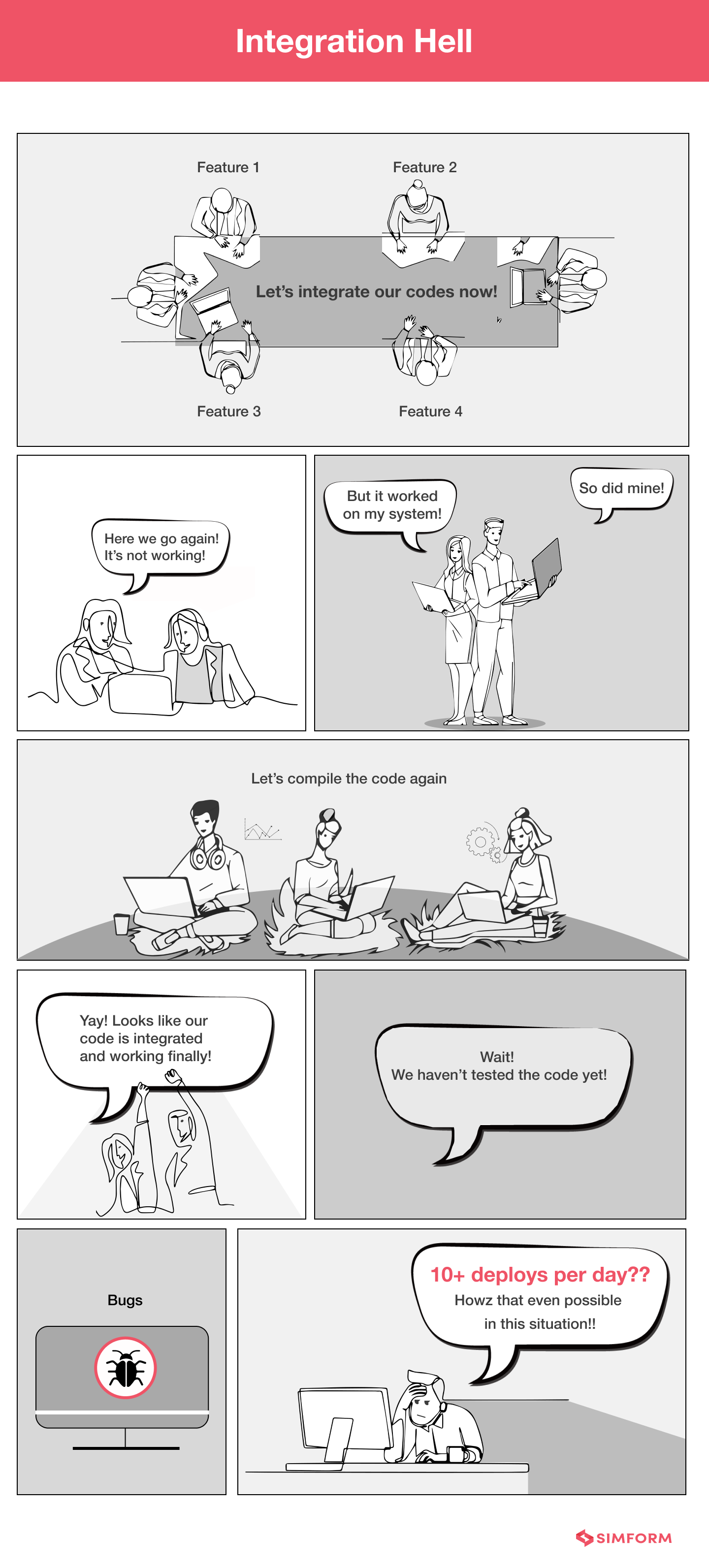
Now, we’ll gradually understand both these methodologies side by side, and in the process, we’ll know how they differ in various contexts.
CI vs. CD: Definitions
CI and CD both work in tandem to enhance the DevOps strategy of an organization. Yet, despite having a mutual goal of automating and streamlining the app development process, these two concepts have different definitions.
What is continuous integration?
Continuous integration is a coding philosophy, a related set of development practices that drives development teams to frequently commit and merge code changes into shared version-control repositories at least once a day. (hourly/daily/weekly merges)
What is continuous delivery?
Continuous delivery, a software development methodology, picks up from where continuous integration ends, i.e., after the build stage, and provides an automated way to push code changes to development, production, and testing environments. CD focuses on keeping the code base at a deployable state.
CI vs. CD: Workflow
Teams with the best technical skills don’t necessarily have the best communication skills. Automated processes can reduce those pain points with streamlined process flow.
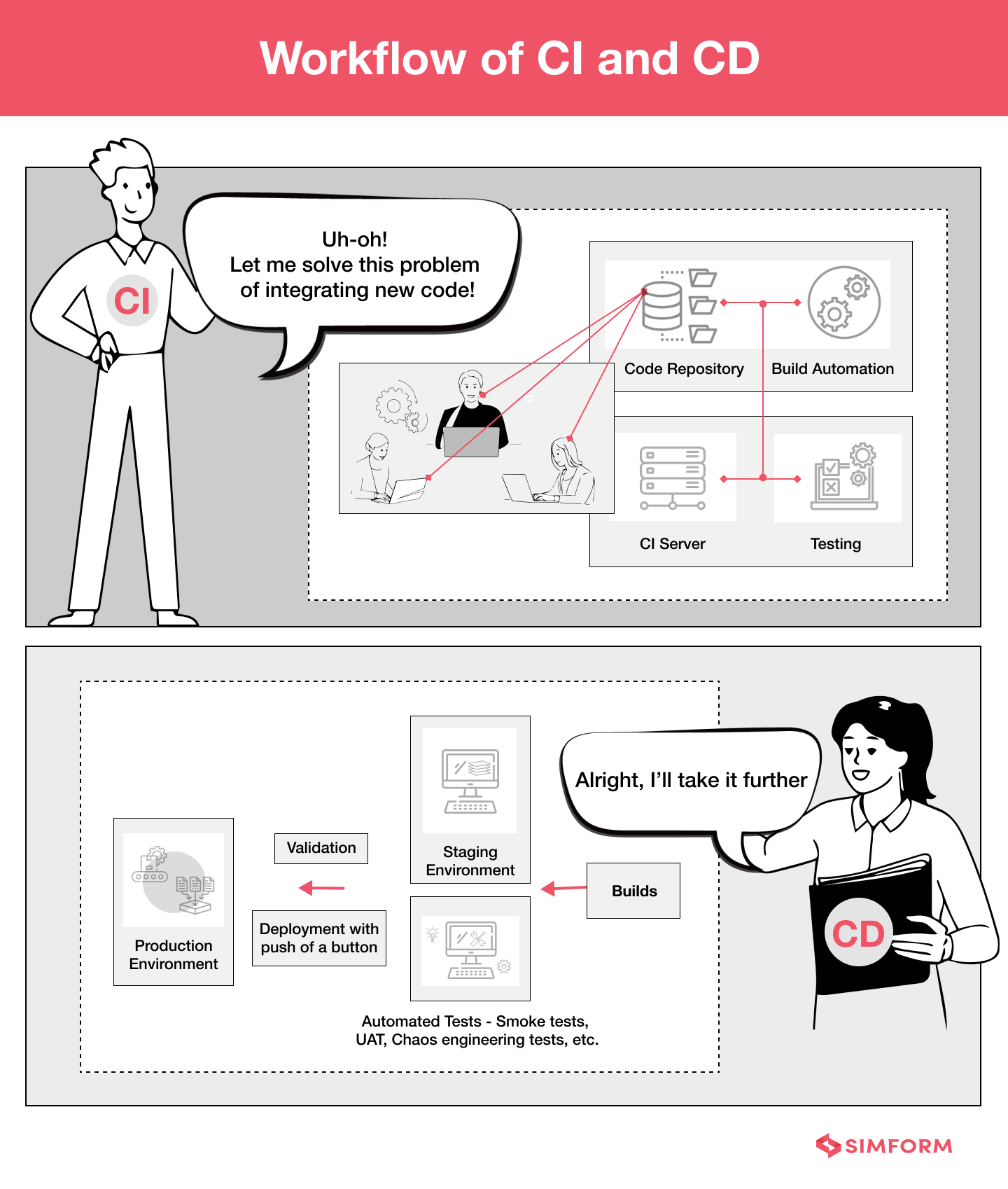
Continuous integration workflow
Here are the key steps that a continuous integration process would generally have in the commit phase for faster feedback.
- Developers “check out” code, i.e., fetch the copy of code from the source code repository into their private workspaces. Then they compile the code and test them locally.
- When done, developers “check in” the edited code into the source control repository.
- A continuous integration server manages the shared repository, initiates a build, and documents the results after developers commit to the repository.
- After a successful build, the CI server –
1) releases deployable artifacts like stylesheets, images, and documents for the application for testing,
2) assigns a build tag to the new version of the code,
3) triggers unit and integrated testing, style check, and static analysis
4) notifies the relevant team about a successful build, or alerts the – development team if a build or test fails
Continuous delivery workflow
The next phase, continuous delivery, is about keeping your code in a deployable state all the time. Here are the steps to implement continuous delivery –
- Build artifacts from the CI step are deployed automatically to a staging environment – a replica of the production stack.
- More tests like smoke tests, user acceptance tests, chaos engineering tests, etc., are conducted. Cloud computing makes it easy to create a staging environment.
- The staging environment can be static when you pre-built it for testing. Or you could configure a dynamic one with committed infrastructure and configuration code.
- Next, the production environment can be built using infrastructure as code (IaC).
- The application can be deployed with the push of a button to a production-like environment then.
Thinking of outsourcing DevOps? Read this comprehensive guide
CI vs. CD: Benefits
There are some apparent benefits of CI and CD as individual processes. For instance, continuous integration improves the end software quality, enhances velocity, and reduces budget. Likewise, continuous delivery ensures a release-ready state for automatic or rapid click-button deployment. Although some benefits would overlap to an extent, here are some of the main advantages of both methodologies.
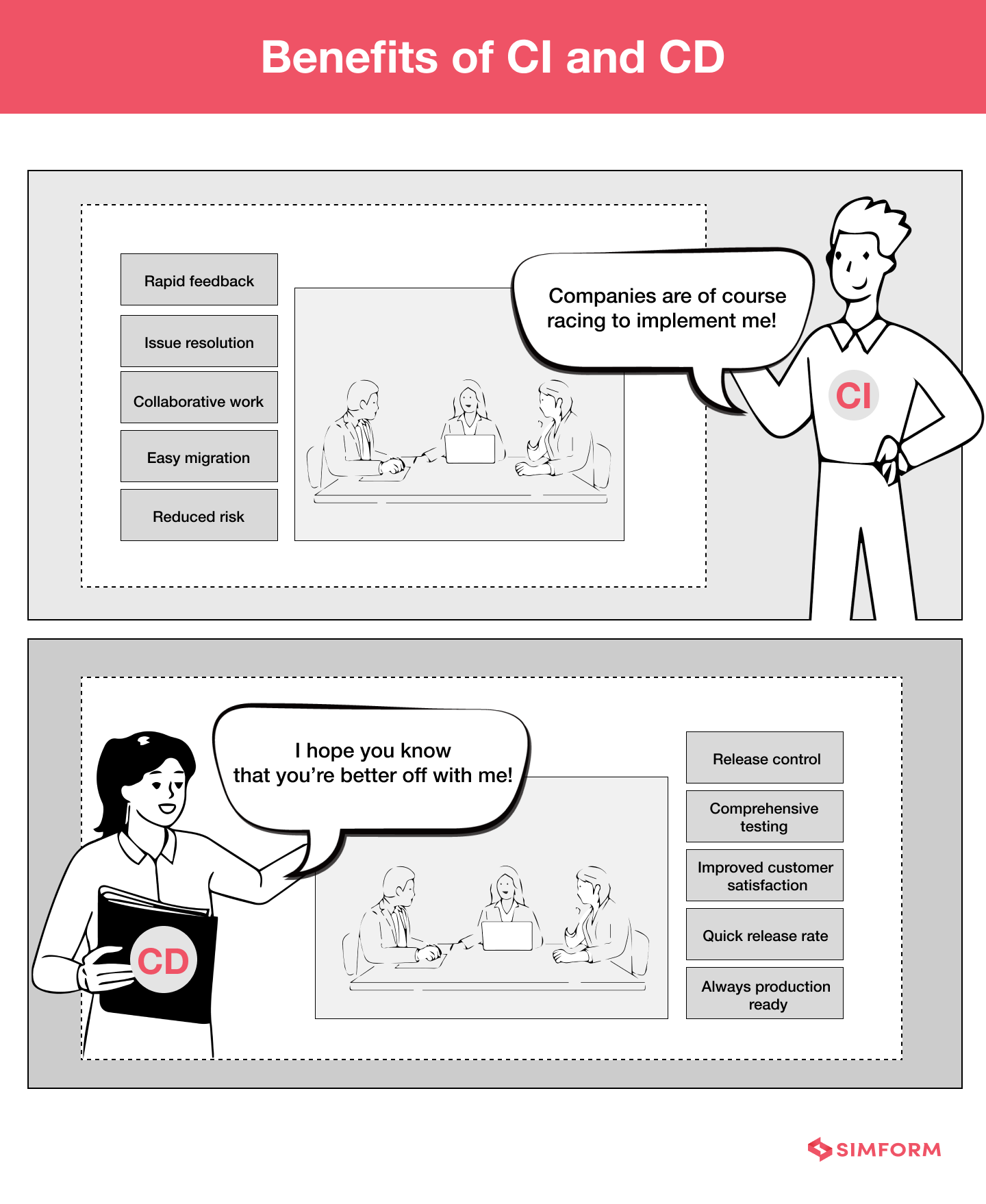
Advantages of continuous integration
- The DevOps team immediately knows about an error condition or a bug in the code base.
- The elaborated build process becomes less prone to human error with automated builds.
- Multiple development teams can effectively work in tandem, quickly responding to evolving needs of a changing market.
- CI enables easy migration from an old software version to a newer one.
Reduced risk because of continuous testing with automated regression and other executed tests.
Advantages of continuous delivery
- Automated testing and monitoring with triggering mechanisms help quickly identify a fault and its location.
- Rapid fault isolation reduces overall MTTR (Mean Time To Repair) as broken features can be quickly repaired, and the system can recover from a failure in no time.
- Faster problem resolution, in turn, expedites release rates for code features.
- The quick addition of features provides customers with the updated product they desire, increasing their satisfaction.
- Production-ready products can undergo more comprehensive testing in various test environments, including load testing, integration testing, system integration testing (SIT), performance testing, and any other required by the organization.
Ultimately, teams can automate the entire software release process and create a fully automated CI/CD pipeline.
CI vs. CD: Benefits to whom?
CI/CD is undoubtedly central to DevOps-driven organizations and agile development. Yes, it cannot always be the correct answer. But, if it’s right and properly implemented, all segments of the companies will have the advantages mentioned above.
However, let’s see who is directly at the receiving end of most advantages.
Continuous integration is boon to developers
CI benefits developers most because it fundamentally enables the code to be automatically tested and continuously “integrated” with the existing codebase and other developers’ code. The developer receives continuous and immediate feedback about code and integration errors. Once they rectify the errors, automated testing tools notify if the errors are successfully fixed and when the code is accepted. The continuous feedback loop increases a developer’s productivity by and large.
Continuous delivery is beneficial for business users
Continuous delivery directly benefits business users because the moment code is successfully accepted in the CI stage and logical functions can be tested; it is released to users. Then, they can confirm whether the features meet their expectations and give feedback to developers who can address the feedback in this stage. In the traditional waterfall method, users might have to wait weeks/months to see the features for the first time, whereas here, the feedback loop between users and developers is seamless and continuous.
CI vs. CD: Challenges
Continuous integration and continuous delivery have become the mainstream approach to software development. Moreover, CI/CD pipeline tools have also significantly matured over the years. Still, CI and CD come at a cost, and developers, QA engineers, and technical leaders often face roadblocks in implementing these processes efficiently. Let’s see what those challenges are.
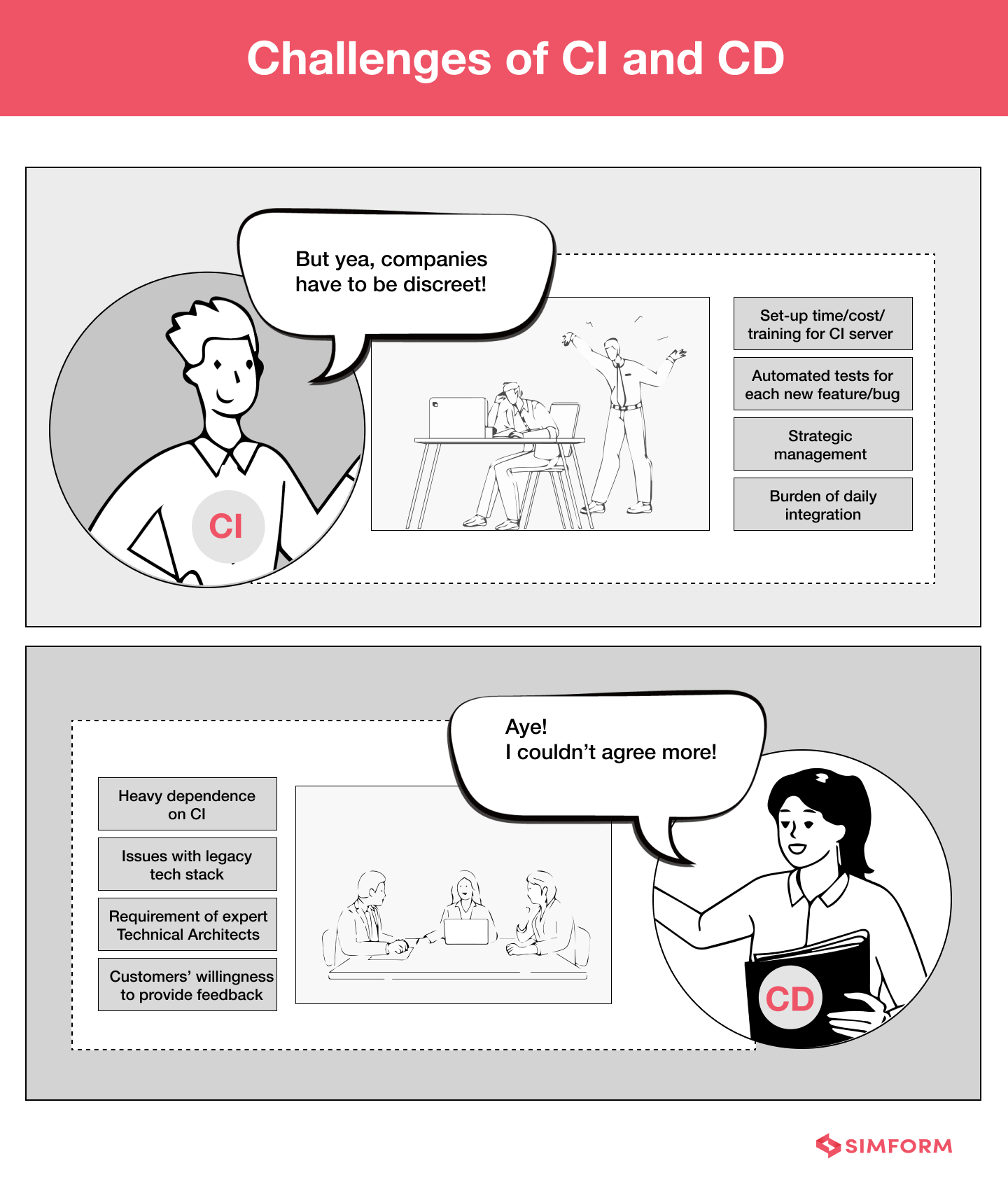
Challenges of continuous integration
- Each developer has to deploy code daily to ensure that there are no outdated assumptions and that the entire team is on the same page, working on the exact mainline copy. This increases the burden of daily integration.
- The testing team needs to write automated tests for every new feature or bug fix.
- Businesses have to invest in terms of time, effort, and budget. A CI server must be set up to monitor the main repository and run the tests for new code commits.
- However, the challenge doesn’t stop at implementation; it demands a consolidated effort from all stakeholders to support and maintain a stable CI; automated release process.
- Larger development teams might have to see CI error messages daily. As a result, they might start ignoring them altogether to focus on other tasks and concerns. If it reaches a stage where a broken build becomes the norm, defects may start accumulating on top of each other.
Challenges of continuous delivery
- A successful CD requires a strong foundation in CI; otherwise, it’d have the issues right from the start and have to operate from a weaker position.
- Continuous delivery might not work best for applications that still use a legacy technology stack.
- Requirement of expert Technical Architects who can efficiently design a continuous delivery pipeline and manage the transition between one version and the next so that continuous delivery is not stopped in its tracks.
- New features and improvements in the product are still delivered manually. So, generally, businesses would need to adopt continuous deployment to automate this process.
- The customer must be willing to use software that is still in development and provide important feedback.
CI vs. CD: Tools
Faster software release requires automation of the entire workflow, not just the testing. It can be challenging to choose the best tools from many available platforms as most of them share similar features. You should pick a tool based on –
- your requirements,
- how you plan to handle your daily workflow,
your tech stack, - how much you are willing to spend
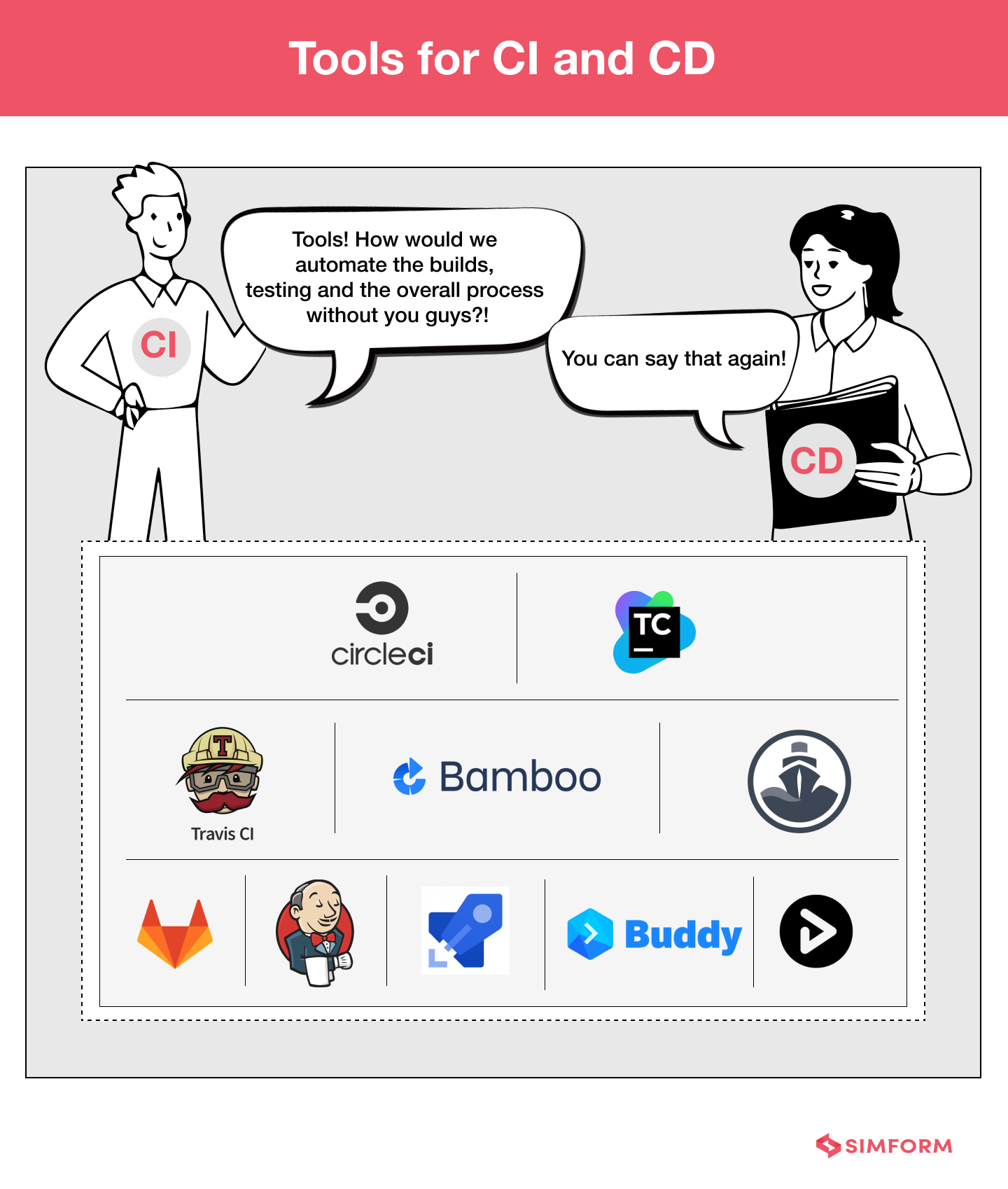
Plugging existing tools into new CD pipelines makes the pipeline more sophisticated. For example, connecting code repositories (GitHub, Bitbucket, etc.) to the CD pipeline triggers the pipeline automatically every time a new artifact is committed. Likewise, the integration of Ansible or Terraform into the pipeline helps create Infrastructure as Code.
CI vs. CD: Best practices
Continuous integration is the foundation for other “continuous” processes. And so, it’s essential to incorporate best practices for CI and CD into your workflow to get the most out of your entire software delivery pipeline.
Best practices for continuous integration
- Ask DevOps team members first to read the documentation provided by continuous integration platforms.
- Efficiently organize the jobs in the stages of the CI pipeline and optimize those stages to identify and fix failures easily.
- Keep things as simple as possible to have a faster production pipeline and builds.
- Focus on developing a “learning” culture rather than a “blaming” one by analyzing “what” caused the failure, not “who.”
- Perform unit tests at every stage in the development to ensure high quality, quick feedback, and realize the real benefits of adopting DevOps.
- Have identical testing and production environments so that developers can rely on the results and deploy with confidence.
- Establish security checks from the beginning of the development life cycle to find security risks before building artifacts or deploying.
Best practices for continuous delivery
- Keep requirement documents, technical documentation, configuration properties, test scripts, upgrade, downgrade & initialization scripts, database creation, etc., in some form of versioned storage.
- The results of running test suites are binary – either a passed or a failed test. Don’t check in anything created as part of your build, test, and deploy cycle into version control; instead, put binaries onto a shared filesystem. And treat these artifacts as metadata associated with the identifier of the revision that triggered the build
- Build binaries only once during the commit stage, and store them in package repositories like Artifactory, Archiva, or Nexus.
- Monitor the continuous delivery pipeline and restart the pipeline if any stage fails.
Continuous integration vs. continuous delivery: Goals
Every part of CI/CD represents specific goals and disciplines to achieve them. And contributing to the confusion are different goals of continuous delivery and continuous integration.
Let’s clear the air with an image where we’ll also consider continuous deployment as an essential “continuation of continuous delivery” for most cases.
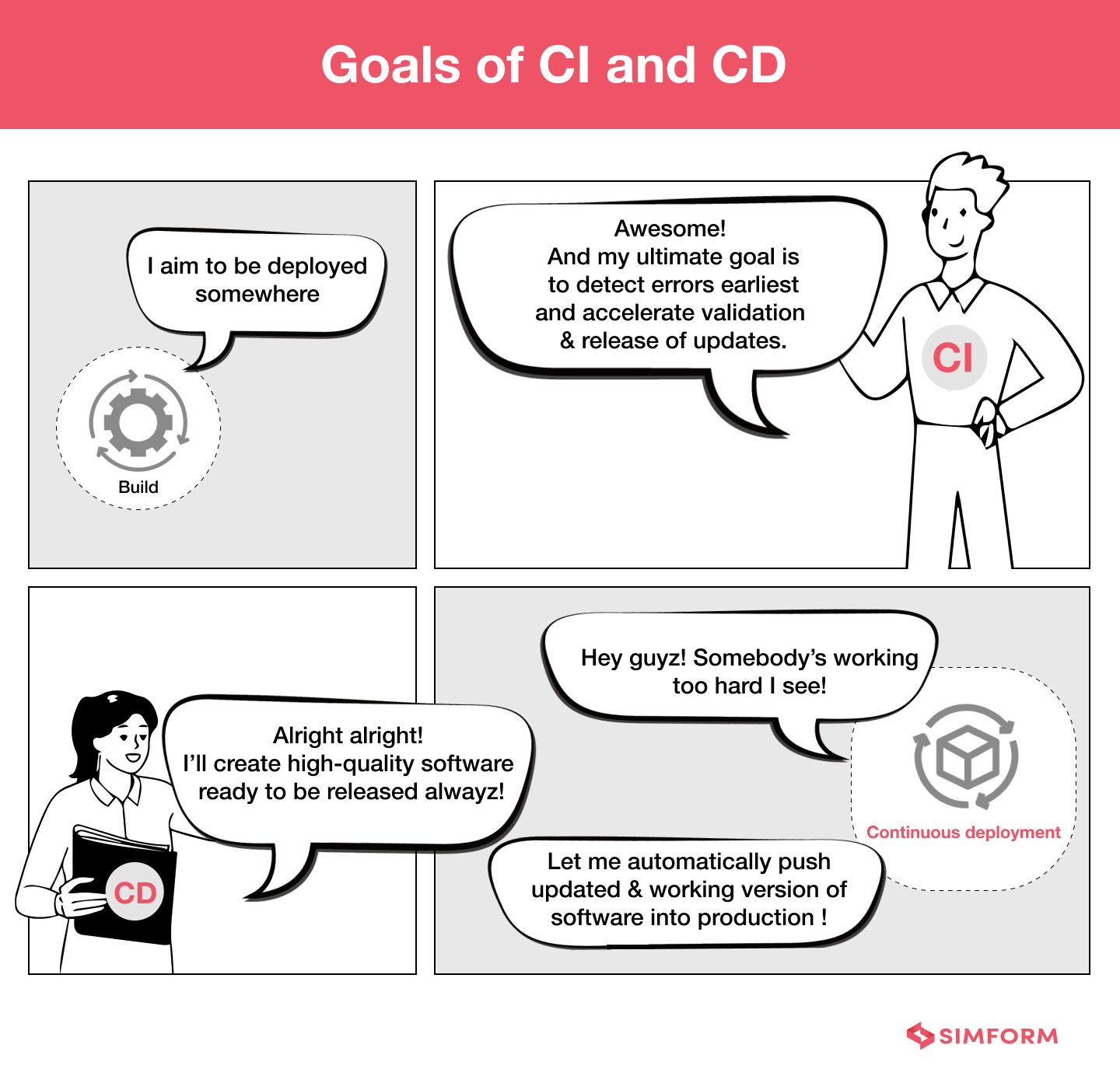
Perils of focusing on continuous integration only
Setting up a CI server to continuously merge and integrate code changes does NOT mean that a DevOps team is practicing continuous delivery. Here, a team might set up a server and push changes to it a few times a day but fail to deploy those changes continuously.
Proper implementation of continuous delivery requires the team to set up software testing, staging, and deployment processes in a way that most of them are automated and take place continuously.
A team that just focuses on CI and believes they’d also achieve continuous delivery is likely to encounter the following issues.
- Software deployment might remain more or less complex, and they might still spend days preparing for a release.
- They might not get one of the main benefits of continuous delivery – a faster feedback loop with the customers.
- The team may have difficulty iterating faster because of the increased pressure on decisions for small changes.
So, it’s quite clear that continuous integration is a must. In fact, implementing CI is a prerequisite to getting continuous delivery, as we often mention. Still, continuous delivery is equally important, if not more so! And as a result, it’s imperative to know the differences between the two to ensure proper implementation of both.
Meanwhile, it is common to confuse continuous delivery with continuous deployment. But, continuous delivery is not continuous deployment!
Continuous delivery vs continuous deployment
Continuous delivery is not about applying every change to production immediately; instead, it’s about ensuring that the software with changes is always ready to go to production.
Continuous deployment is a special case, an extension of continuous delivery that might not be applicable to all systems. CD focuses on the actual “deployment” and automates the entire process from code commit to production. You must consider deployment automation by practicing continuous deployment if
- Your system and gating requirements support and allow for end-to-end automation
- You don’t need approval from stakeholders for deployment
- Your organization can quickly respond to errors in production.
- You can gradually expose your customers to production changes.
If not, you might want to start with continuous integration and continuous delivery. This way, you can automate the creation of production-ready code that’d always be a single manual approval away from deployment. Then, over time, you can find your way towards continuous deployment and complete automation of your software delivery process.
CI and CD combinedly enhance software deployment!
Everything that is “continuous,” like continuous integration, continuous delivery, continuous deployment, and even continuous monitoring, are critical DevOps practices.
At the end of the day, it’s not much about continuous integration vs. continuous delivery; or even continuous integration vs. continuous deployment! Instead, it’s continuous integration AND continuous delivery! And there’s a reason behind that! Despite having the differences, both processes work towards a mutual goal: to minimize human intervention in software development and make releases more frequent, robust, and reliable. Partner with an established firm like Simform to become more agile with modern software delivery capabilities.
